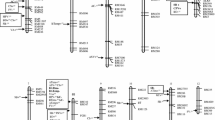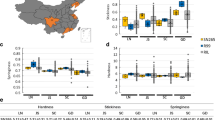Abstract
A recombinant inbred line population derived from a cross between Zhenshan 97 and Delong 208 was used to analyze the genetic basis of the cooking and eating quality of rice as reflected by 17 traits (or parameters). These traits include amylose content (AC), gel consistency (GC), alkali spreading value (ASV), cooked rice elongation (CRE), and 13 parameters from the viscosity profile. All the traits, except peak paste viscosity (PKV), time needed from gelatinization to peak (BAtime), and CRE, can be divided into two classes according to their interrelationship. The first class consists of AC, GC, and most of the paste viscosity parameters that form a major determinant of eating quality. The second class includes ASV, pasting temperature (Atemp) and pasting time (Atime), which characterize cooking process. We identified 26 QTL (quantitative trait locus or loci) in 2 years; nine QTL clusters emerged. The two major clusters, which correspond to the Wx and Alk loci, control the traits in the first and second classes, respectively. Some QTL are co-located for the traits belonging to the same class and also for the traits to a different class. The Wx locus also affects on ASV while the Alk locus also makes minor contributions to GC and some paste viscosity parameters. The QTL clusters on other chromosomes are similar to the Wx locus or Alk locus, although the variations they explained are relatively minor. QTL for CRE and PKV are dispersed and independent of the Wx locus. Low paste viscosity corresponds to low AC and soft gel, which represents good eating quality for most Chinese consumers; high ASV and low Atemp, together with reduced time to gelatinization and PKV, indicate preferred cooking quality. The genetic basis of Atemp, Atime, BAtime, peak temperature, peak time, paste viscosity at 95°C, and final paste viscosity is newly examined to reveal a complete and dynamic viscosity profile.




Similar content being viewed by others
References
Ahn SN, Bollich CN, McClung AM, Tanksley SD (1993) RFLP analysis of genomic regions associated with cooked-kernel elongation in rice. Theor Appl Genet 87:27–32
Aluko G, Martinez C, Tohme J, Castano C, Bergman C, Oard JH (2004) QTL mapping of grain quality traits from the interspecific cross Oryza sativa × O. glaberrima. Theor Appl Genet 109:630–639
American Association of Cereal Chemists (2000) Approved methods for the AACC, 10th edn. Method 61-01 (amylograph method for milled rice) and Method 61-02 (determination of the pasting properties of rice with rapid visco analyzer). The Association, St. Paul
Ayres NM, McClung AM, Larkin PD, Bligh HFJ, Jones CA, Park WD (1997) Microsatellites and a single-nucleotide polymorphism differentiate apparent amylose classes in an extended pedigree of US rice germplasm. Theor Appl Genet 94:773–781
Bao JS, Xia YW (1999) Genetic control of the paste viscosity characteristics in indica rice (Oryza sativa L.) Theor Appl Genet 98:1120–1124
Bao JS, He P, Li SG, Xia YW, Chen Y, Zhu LH (2000a) Comparative mapping quantitative trait loci controlling the cooking and eating quality of rice. Sci Agri Sin 33:8–13
Bao JS, Zheng XW, Xia YW, He P, Shu QY, Lu X, Chen Y, Zhu LH (2000b) QTL mapping for the paste viscosity characteristics in rice (Oryza sativa L.). Theor Appl Genet 100:280–284
Bao JS, Wu YR, Hu B, Wu P, Cui HR, Shu QY (2002) QTL for rice grain quality based on a DH population derived from parents with similar apparent amylase content. Euphytica 128:317–324
Bao JS, Harold C, He P, Zhu LH (2003) Analysis of quantitative trait loci for starch properties of rice based on an RIL population. Acta Bot Sin 45:986–994
Cagampang GB, Perez CM, Juliano BO (1973) A gel consistency test for eating quality in rice. J Sci Food Agr 24:1589–1594
Dong YJ, Zheng YF (2002) Quantitative trait loci controlling steamed-rice shape in a recombinant inbred population. IRRN 27:19–20
Fan CC, Yu XQ, Xing YZ, Xu CG, Luo LJ, Zhang QF (2005) The main effects, epistatic effects and environmental interactions of QTLs on the cooking and eating quality of rice in a doubled-haploid line population. Theor Appl Genet 110:1445–1452
Ge XJ, Xing YZ, Xu CG, He YQ (2005) QTL analysis of cooked rice grain elongation, volume expansion, and water absorption using a recombinant inbred population. Plant Breed 124:121–126
Gravois KA, Webb BD (1997) Inheritance of long grain rice amylograph viscosity characteristics. Euphtica 97:25–29
Harushima Y, Yano M, Shomura A, Sato M, Shimano T, Kuboki Y, Yamamoto T, Lin SY, Antonio BA, Parco A, Kajiya H, Huang N, Yamamoto K, Nagamura Y, Kurata N, Khush GS, Sasaki T (1998) A high-density rice genetic linkage map with 2,275 markers using a single F2 Population. Genetics 148:479–494
He P, Li SG, Qian Q, Ma YQ, Li JZ, Wang WM, Chen Y, Zhu LH (1999) Genetic analysis of rice grain quality. Theor Appl Genet 98:502–508
Jiang GH, He YQ, Xu CG, Li XH, Zhang Q (2004) The genetic basis of stay-green in rice analyzed in a population of doubled haploid lines from an indica by japonica cross. Theor Appl Genet 108:688–698
Juliano BO (1985) Rice chemistry and technology, 2nd edn. American Association of Cereal Chemists, Incorporated Saint Paul, Minnesota
Juliano BO (1996) Rice quality screening with the Rapid Visco Analyser. In: Walker CE, Hazelton JL (eds) Applications of the Rapid Visco Analyser. Newport Scientific, Sydney, pp 19–24
Kudo M (1968) Genetical and thremmatological studies of characters, physiological or ecological, in the hybrids between ecological rice groups. Bull Natl Inst Agric Sci Ser D 19:1–84
Lanceras JC, Huang ZL, Naivikul O, Vanavichit A., Ruanjaichon V., Tragoonrung S (2000) Mapping of genes for cooking and eating qualities in Thai jasmine rice (KDML105). DNA Res 7:93–101
Larkin PD, Park WD (2003) Association of waxy gene single nucleotide polymorphisms with starch characteristics in rice (Oryza sativa L.). Mol Breed 12:335–339
Lincoln S, Daly M, Lander E (1992) Constructing genetics maps with MAPMAKER/EXP 3.0. Whitehead Institute Technical Report, Whitehead Institute, Cambridge
Little RR, Hilder GB, Dawson EH (1958) Differential effect of dilute alkali on 25 varieties of milled white rice. Cereal Chem 35:111–126
McCouch SR, Teytelman L, Xu Y, Lobos KB, Clare K, Walton M, Fu B, Maghirang R, Li Z, Xing Y, Zhang Q, Kono I, Yano M, Fjellstrom R, DeClerck G, Schneider D, Cartinhour S, Ware D, Stein L (2002) Development and mapping of 2,240 new SSR markers for rice (Oryza sativa L.). DNA Res 9:199–207
Panozzo JF, McCormick KM (1993) The Rapid Visco Analyser as a test method of testing for noodle quality in a wheat breeding programme. J Cereal Sci 17:25–32
Septiningsih EM, Trijatmiko KR, Moeljopawiro S, McCouch SR (2003) Identification of quantitative trait loci for grain quality in an advanced backcross population derived from the Oryza sativa variety IR64 and the wild relative O. rufipogon. Theor Appl Genet 107:1433–1441
Shu QY, Wu DX, Xia YW, Gao MW, McClung A (1998) Relationship between RVA profile character and eating quality in Oryza sativa L. Sci Agric Sinica 31:25–29
StatSoft (1991) Statistica. StatSoft, Tulsa
Tan YF, Li JX, Yu SB, Xing YZ, Xu CG, Zhang QF (1999) The three important traits for cooking and eating quality of rice grains are controlled by a single locus in an elite rice hybrid, Shanyou 63. Theor Appl Genet 99:642–648
Temnykh S, Park WD, Ayres N, Cartihour S, Hauck N, Lipovich L, Cho YG, Ishii T, McCouch SR (2000) Mapping and genome organization of microsatellite sequences in rice (Oryza sativa L.). Theor Appl Genet 100:697–712
Temnykh S, Declerck G, Luashova A, Lipovich L, Cartinhour S, McCouch S (2001) Computational and experimental analysis of microsatellites in rice (Oryza sativa L.): frequency, length variation, transposon associations, and genetic marker potential. Genome Res 11:1441–1452
Tian R, Jiang GH, Shen LH, Wang LQ, He YQ (2005) Mapping quantitative trait loci underlying the cooking and eating quality of rice using a DH population. Mol Breed 15:117–124
Umemoto T, Aoki N (2005) Single-nucleotide polymorphisms in rice starch synthase IIa that alter starch gelatinization and starch association of the enzyme. Funct Plant Biol 32:763–768
Umemoto T, Yano M, Satoh H, Shomura A, Nakamura Y (2002) Mapping of a gene responsible for the difference in amylopectin structure between japonica-type and indica-type rice varieties. Theor Appl Genet 104:1–8
Unnevehr LJ, Duff B, Juliano BO (1992) Consumer demand for rice grain quality. International Rice Research Institute, Manila, The Philippines and International Development Research Centre, Ottawa
Webb BD (1991) Rice quality and grades. In: Luh B (eds) Rice utilization, vol VII. Van Nostrand Reinhold, New York, pp 89–116
Wrigley CW, Booth RI, Bason ML, Walker CE (1996) Rapid Visco Analyser: progress from concept to adaptation. Cereal Foods World 41:6–11
Zeng ZB (1994) Precision mapping of quantitative trait loci. Genetics 136:1457–1468
Acknowledgments
This work was supported in part by a grant from the National Program on the Development of Basic Research, the National Program of High Technology Development, and a grant from the National Natural Science Foundation of China.
Author information
Authors and Affiliations
Corresponding author
Additional information
Communicated by P. Langridge.
Rights and permissions
About this article
Cite this article
Wang, L.Q., Liu, W.J., Xu, Y. et al. Genetic basis of 17 traits and viscosity parameters characterizing the eating and cooking quality of rice grain. Theor Appl Genet 115, 463–476 (2007). https://doi.org/10.1007/s00122-007-0580-7
Received:
Accepted:
Published:
Issue Date:
DOI: https://doi.org/10.1007/s00122-007-0580-7




